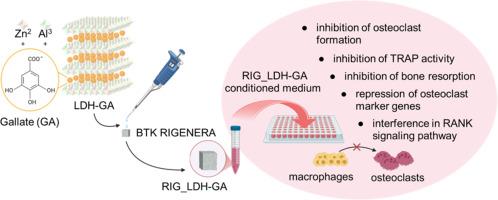Gallic acid released by a layered double hydroxide-coated scaffold of hydroxyapatite and β-tricalcium phosphate inhibits the osteoclast formation In Vitro
Q3 Biochemistry, Genetics and Molecular Biology
引用次数: 0
Abstract
Following dental extraction, alveolar bone loss, driven by the osteoclast (OC) bone-eroding cells, is a relevant concern in dental practice since it could compromise the possibility of installing dental implants. This study aimed to develop a drug delivery system releasing the antiosteoclastogenic molecule gallic acid (GA) at the alveolar bone level to control the dysregulated balance between OCs and bone-building osteoblasts and thus delay bone erosion. We functionalized small blocks of the hydroxyapatite- and β-tricalcium phosphate-based RIGENERA BTK BCP biomaterial with layered double hydroxide (LDH) and GA (RIG_LDH-GA). By the in vitro model of Receptor Activator of Nuclear factor Kappa-Β Ligand (RANKL)-induced osteoclastogenesis in RAW 264.7 macrophages, we demonstrated that the conditioned medium (CM) obtained after 1-day incubation with RIG_LDH-GA contrasts the OC formation in a dose-dependent manner until a complete inhibition at the highest tested dose, while the unfunctionalized control (RIG) is ineffective. TRAP enzyme activity, OC marker gene expression, and bone resorption activity confirmed the antiosteoclastogenic effect of RIG_LDH-GA CM. Moreover, the expression of RANK (the RANKL’s receptor), otherwise induced by RANKL treatment, was reduced to the untreated control extent, consistent with the decreased expression of the transcription factors c-Fos and NFATc1, activated downstream in the RANK signaling pathway and inducing RANK itself. Thus, since GA released by the RIG_LDH-GA system effectively exerted an antiosteoclastogenic effect, RIGENERA BTK BCP functionalization with LDH and GA likely appears to be an osteoprotective upgrade of this biomaterial, already possessing bone regenerative properties, and might find successful clinical application in preventing osteoclast-mediated alveolar bone loss.

羟基磷灰石和β-磷酸三钙层状双羟基包被支架释放没食子酸抑制体外破骨细胞的形成
拔牙后,破骨细胞(OC)骨侵蚀细胞导致的牙槽骨丢失是牙科实践中一个值得关注的问题,因为它可能会影响种植体的安装。本研究旨在开发一种在牙槽骨水平释放抗破骨细胞分子没食子酸(GA)的药物递送系统,以控制OCs与成骨细胞之间的失调平衡,从而延缓骨侵蚀。我们用层状双氢氧化物(LDH)和GA (RIG_LDH-GA)功能化了小块羟基磷灰石和β-磷酸三钙基的RIGENERA BTK BCP生物材料。通过RANKL诱导RAW 264.7巨噬细胞破骨形成的体外模型,我们证明了与RIG_LDH-GA孵育1天后获得的条件培养基(CM)以剂量依赖的方式对比OC的形成,直到在最高测试剂量下完全抑制,而非功能化对照(RIG)无效。TRAP酶活性、OC标记基因表达和骨吸收活性证实了RIG_LDH-GA CM的抗破骨作用。此外,RANKL处理诱导的RANKL受体RANK的表达降低到未处理的对照水平,这与在RANK信号通路下游激活并诱导RANK本身的转录因子c-Fos和NFATc1表达降低一致。因此,由于RIG_LDH-GA系统释放的GA有效地发挥了抗破骨作用,因此LDH和GA对RIGENERA BTK BCP的功能化可能是对这种已经具有骨再生特性的生物材料的骨保护升级,并可能在预防破骨细胞介导的牙槽骨丢失方面获得成功的临床应用。
本文章由计算机程序翻译,如有差异,请以英文原文为准。
求助全文
约1分钟内获得全文
求助全文

 求助内容:
求助内容: 应助结果提醒方式:
应助结果提醒方式:


